Cangarda, the touchscreen steam yacht

Camden Harbor is pretty quiet these days, but on Monday afternoon -- while I was stripping electronics off Gizmo prior to her inevitable haul-out -- Cangarda, the only existing U.S.-built steam yacht, suddenly slipped around the corner and silently maneuvered onto the Wayfarer dock just ahead of me. Yesterday I was further thrilled when Capt. Steve Cobb himself showed me around, paying special attention to his beloved engine room, where he'd fired up the boiler in order to check that the "water chemistry" was proper for lay up. You see, I already knew a fair bit about Cangarda, though I'd never seen the 126 foot vessel in all her awesome flesh before...
In fact, when I wrote about Cangarda in 2003, largely with Cobb's help, she was just an empty worn-out hull, a warehouse of dusty parts, and a gleam in his eye. But the story sort of worked out as hoped, as you can read in part at Wikipedia. Bob McNeil bought the "kit," shipped it all to Rutherford's Boatshop (lots of good photos), and for years Cobb spent long periods in California helping to execute what might be called a hybrid restoration. Because McNeil wanted to actually cruise Cangarda is a semi-practical manner, he switched her coal-fired boiler to an automated diesel-fired system. Which is why you see the incredible juxaposition below of a 1901 triple expansion steam engine -- that runs now like it did then -- alongside an elaborate touchscreen boiler control system. And no worries about that scary-looking slate and knife-switch electrical panel; it's purely decorative as the yacht now has up-to-code wiring and two diesel generators (tucked in where the coal bins used to be)...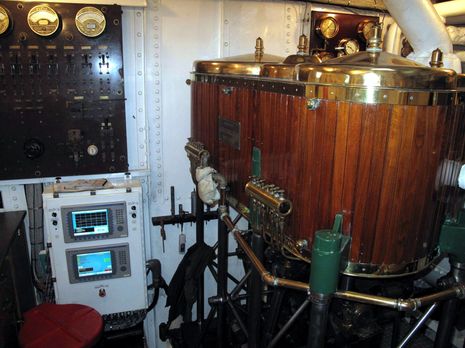 But as useful as those screens may be, like the trend graph below, Capt. Cobb made it clear that the boiler can be operated without the automation (which was engineered by Innovative Control Solutions). He even showed me the very long "match" he's uses to test his ability to fire up the furnace manually. And he also demonstrated his preferred manner of operating the main engine...
But as useful as those screens may be, like the trend graph below, Capt. Cobb made it clear that the boiler can be operated without the automation (which was engineered by Innovative Control Solutions). He even showed me the very long "match" he's uses to test his ability to fire up the furnace manually. And he also demonstrated his preferred manner of operating the main engine... 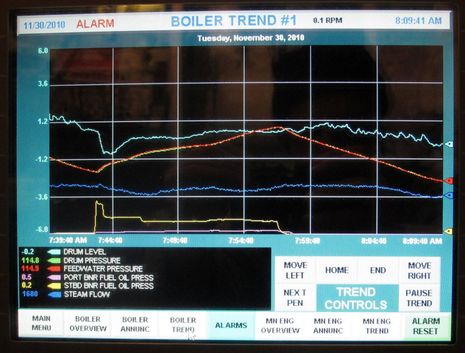 In the photo below, Steve's right hand is on the shift lever that's directly attached to the ingenious reversing mechanism (apparently designed, at least in part, by Nathanael Herrshoff) and to the left of his head is the throttle that's directly attached to the large insulated steam valve. The brass bell system is, of course, how the bridge crew communicate their shift and throttle desires. The modern Cangarda does have remotely switched hydraulic actuators for both controls, but Steve was standing right here when they came into Camden, while his able mate did the driving. Heck, besides being able to mother the machinery, from here he can control propulsion to a docking exactitude like "reverse five turns" -- easy to count when you're looking at a huge exposed crank shaft on an engine whose RPMs only range from 15 to about 200!
In the photo below, Steve's right hand is on the shift lever that's directly attached to the ingenious reversing mechanism (apparently designed, at least in part, by Nathanael Herrshoff) and to the left of his head is the throttle that's directly attached to the large insulated steam valve. The brass bell system is, of course, how the bridge crew communicate their shift and throttle desires. The modern Cangarda does have remotely switched hydraulic actuators for both controls, but Steve was standing right here when they came into Camden, while his able mate did the driving. Heck, besides being able to mother the machinery, from here he can control propulsion to a docking exactitude like "reverse five turns" -- easy to count when you're looking at a huge exposed crank shaft on an engine whose RPMs only range from 15 to about 200!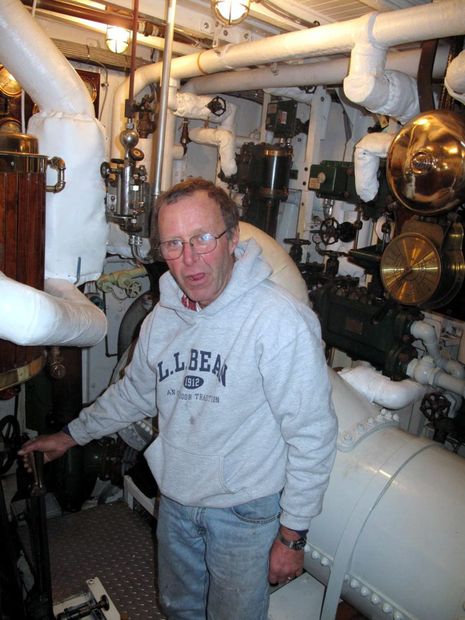 Below is a starboard view of that crank, which connects directly to a 65 foot shaft and a five-foot, five-bladed prop. Behind it you can make out the secondary shaft used for shifting, and in several places you can also see the copper pipes used to drip oil into critical bearings from the manifolds seen a few photos up attached to the wooden cover around the pistons (which vary in size from 9 inches to 24, as explained in my original article). Some oiling is meant to be done by hand, however...
Below is a starboard view of that crank, which connects directly to a 65 foot shaft and a five-foot, five-bladed prop. Behind it you can make out the secondary shaft used for shifting, and in several places you can also see the copper pipes used to drip oil into critical bearings from the manifolds seen a few photos up attached to the wooden cover around the pistons (which vary in size from 9 inches to 24, as explained in my original article). Some oiling is meant to be done by hand, however...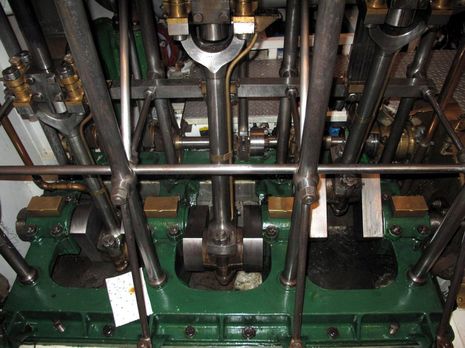 In the shifting shaft closeup below you can see a couple of oil cups...that are filled with hair, horse hair to be specific, which is apparently a traditional and effective way to both filter out grit and to encourage a squirt of oil to enter the bearing at a judicious rate. (The water splashes, by the way, are there because the cylinders had just been purged as part of the boiler shut down procedure.) Steve's expertise, and passion, about all this sort of detail is infectious, and I do hope to one day see the big engine in action. In the meantime, I did get to experience a couple of Cangarda's smaller steam motors...
In the shifting shaft closeup below you can see a couple of oil cups...that are filled with hair, horse hair to be specific, which is apparently a traditional and effective way to both filter out grit and to encourage a squirt of oil to enter the bearing at a judicious rate. (The water splashes, by the way, are there because the cylinders had just been purged as part of the boiler shut down procedure.) Steve's expertise, and passion, about all this sort of detail is infectious, and I do hope to one day see the big engine in action. In the meantime, I did get to experience a couple of Cangarda's smaller steam motors...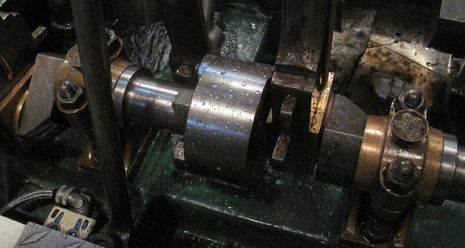 The little steam-powered pump below was quietly chugging away the whole time I was in Cangarda's engine room -- pulling water out of the condenser and back into the boiler, if I recall correctly -- and it gave me a sense of how pleasantly different steam is from internal combustion. And how fascinatingly exposed and complex the whole rig is. I wondered, in fact, if the restored Cangarda -- which voyaged from San Francisco to Mexico and then from Ft. Lauderdale to New England since last April (the middle passage was the deck of a ship) -- has ever operated without Steve on board. The answer is "nope."
The little steam-powered pump below was quietly chugging away the whole time I was in Cangarda's engine room -- pulling water out of the condenser and back into the boiler, if I recall correctly -- and it gave me a sense of how pleasantly different steam is from internal combustion. And how fascinatingly exposed and complex the whole rig is. I wondered, in fact, if the restored Cangarda -- which voyaged from San Francisco to Mexico and then from Ft. Lauderdale to New England since last April (the middle passage was the deck of a ship) -- has ever operated without Steve on board. The answer is "nope." 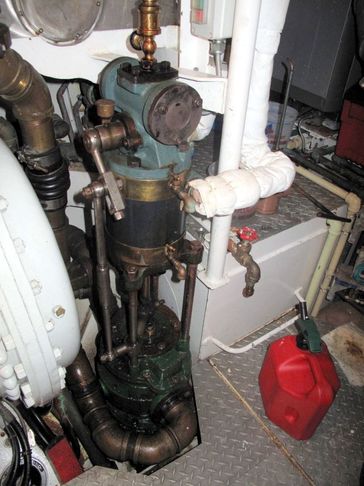 Those long passages were no doubt easier because in addition to the open bridge you can see in the historic photos, Cangarda now has a modest pilothouse fit into the forward end of what used to be simply a dining salon. There wasn't room for another wheel, so steering is done with a little jog stick when the Raymarine autopilot isn't taking care of it. This is about all you may see of electronics on the yacht -- aside from one more boiler control screen discretely mounted on the bridge -- because the radar dome as well as an Iridium OpenPort sat coms dome are used on removable mounts. And she does look striking...
Those long passages were no doubt easier because in addition to the open bridge you can see in the historic photos, Cangarda now has a modest pilothouse fit into the forward end of what used to be simply a dining salon. There wasn't room for another wheel, so steering is done with a little jog stick when the Raymarine autopilot isn't taking care of it. This is about all you may see of electronics on the yacht -- aside from one more boiler control screen discretely mounted on the bridge -- because the radar dome as well as an Iridium OpenPort sat coms dome are used on removable mounts. And she does look striking... 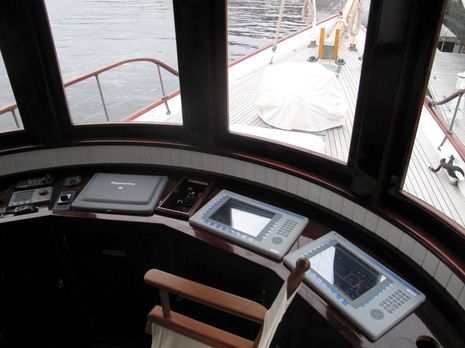 The photo taken from Gizmo below doesn't do her real justice, but you can detect a whiff of smoke from the boiler, and that is one of Capt. Cobb's former rides shrink wrapped at the left -- he was owner and master of the schooner Mary Day for several years. I'm really glad he's back in the harbor, at least for this winter, and what a yacht he brought with him.
The photo taken from Gizmo below doesn't do her real justice, but you can detect a whiff of smoke from the boiler, and that is one of Capt. Cobb's former rides shrink wrapped at the left -- he was owner and master of the schooner Mary Day for several years. I'm really glad he's back in the harbor, at least for this winter, and what a yacht he brought with him.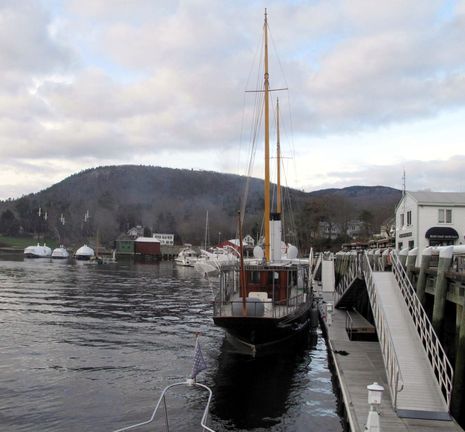 PS Thanks to Tom Babbitt of East Coast Yacht Sales, here's a great shot of Cangarda steaming by Gizmo on Monday, with the mate on the wheel and engine telegraph. See what I mean by an open bridge! Note that my hand is just visible at left, and if the frame was wider I dare guess my mouth was open. Shortly thereafter, I did scurry down to the bow, but Cangarda slipped by with maybe a foot to spare, which was darn impressive, especially given that the yacht's stern is about 90 feet aft of the bridge.
PS Thanks to Tom Babbitt of East Coast Yacht Sales, here's a great shot of Cangarda steaming by Gizmo on Monday, with the mate on the wheel and engine telegraph. See what I mean by an open bridge! Note that my hand is just visible at left, and if the frame was wider I dare guess my mouth was open. Shortly thereafter, I did scurry down to the bow, but Cangarda slipped by with maybe a foot to spare, which was darn impressive, especially given that the yacht's stern is about 90 feet aft of the bridge.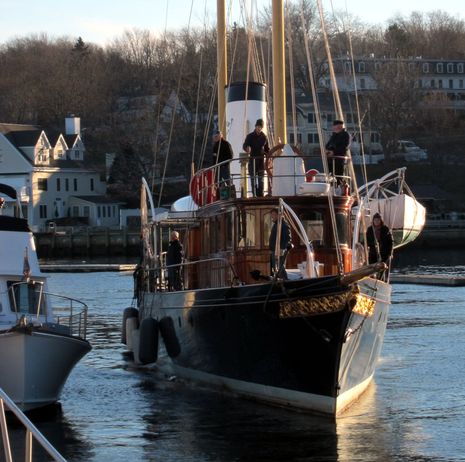

 Share
Share
wow! what a beauty!
-mo